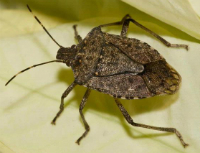New Pest in Austin Texas
 COLLEGE STATION – With the holiday season gearing up, Texas A&M AgriLife Extension Service entomologists are urging travelers to be wary of a new species of unwelcome six-legged hitchhikers itching to become full-time Texans and pest control Austin customers should keep an eye out. These guys are coming in fast!
COLLEGE STATION – With the holiday season gearing up, Texas A&M AgriLife Extension Service entomologists are urging travelers to be wary of a new species of unwelcome six-legged hitchhikers itching to become full-time Texans and pest control Austin customers should keep an eye out. These guys are coming in fast!
“We’re working to raise awareness about the brown marmorated stink bug in Texas,” said Bill Ree, AgriLife Extension entomologist at College Station. “This pest is hitting some states hard. It’s a great hitchhiker which is probably one, if not the main reason, it has spread to so many states. Adults seeking overwintering sites tend to get in recreational vehicles, travel trailers, etc.”
Ree said the pest can cause lasting foul smells in homes and other confines, plus cause major damage to a wide variety of crops and plants.
“So far, we’ve only had one confirmed in Texas, Ree said. “That single find last November at Corpus Christi was from a pest control operator investigating a stink bug infestation in a trailer or RV that had been moved to Corpus from Pennsylvania.
“That’s why we want the public, pest control operators and those in the landscape industry to be aware that we really want to know about possible sites before they escalate as they have elsewhere. New detections in Texas will more likely come from this group of folks, rather than an agricultural ‘bug scout’ in the middle of a soybean field.”
Wizzie Brown, AgriLife Extension urban entomologist at Austin, said the pest is not a health threat to people or animals, but she does see the potential for the insect to become a problem in a variety of outdoor settings.
“It’s possible that it’s already in various parts of the state, and people don’t know about it, so they’re not reporting it,” she said.
Brown said the pest is originally from Asia and is found in China, Japan, Taiwan and Korea. It was spotted in Pennsylvania in 1998 and has spread from there.
“Since it’s an invasive species, natural predators and parasites can’t help to keep populations in check,” she said. “It also seems that the pesticides we have do not do much to help manage the populations.”
Dr. Charles Allen, AgriLife Extension entomologist at San Angelo, said populations in Pennsylvania, Delaware, Maryland, Virginia, West Virginia and other states have built up to high levels as they feed on apples, peaches and other fruits.
“We think this stink bug will feed on pecans in Texas, adding to the losses we may experience from it,” Allen said. “And will probably be a huge problem in grapes because just one or a few stink bugs can taint the flavor of a whole vat of wine.”
Allen said they also indiscriminately dine on tomatoes, peppers and a wide variety of other garden crops and ornamentals and could pose a threat to those industries.
“Our main concerns among Texas field crops are soybeans, pecans and possibly cotton,” Allen said.
“In the fall when they start looking for a place to spend the winter, they can cause problems for homeowners. In some areas of other states, they have entered homes by the thousands and tens of thousands where they leave a very lasting and foul odor. So they are not only an agricultural problem, but also a very troublesome household pest. Folks in the worst affected areas vacuum them up daily, and their homes still smell like stink bugs for weeks.”
Brown said as with most home insect invaders, excluding them from the home is the best and safest course of action, should the pests gain a foothold in Texas.
In the meantime, the entomologists are asking all Texans to report and submit suspected samples so they can confirm if and where the insects may be taking up residence in the state.
“Though they are not a direct human health threat, they are a nuisance that could live almost anywhere in Texas,” Brown said.
“The brown marmorated stink bug looks just like other stink bugs, but it’s a drab brown with black mottling on its back and a distinctive pattern of alternating white and black triangles around the outside of the abdomen. If folks start noticing a new stink bug, one they haven’t seen before, then we want to know about it.”
Samples should include the name and contact information of the sender, the location the bug was found, and the plant or place where it was found. Ree said specimens should be put in something like a pill bottle (preferably dead) and sent to Kira Metz, Minnie Belle Heep Building 216D, 2475 TAMU, College Station, TX 77843-2475. The specimens could also be sent to any AgriLife Extension agent, but those will also be confirmed by Metz.
Metz is the U.S. Department of Agriculture domestic insect identifier headquartered on the Texas A&M University Campus at College Station.
Writer: Steve Byrns, 325-653-4576, [email protected]Contacts: Bill Ree, 979-845-6479, [email protected]Wizzie Brown, 512-854-9600, [email protected]Dr. Charles Allen, 325-653-4576, [email protected]
